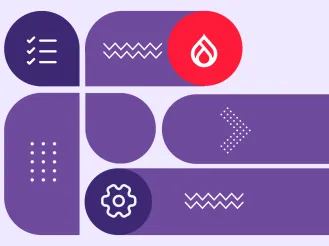How to Use Qualitative Insights to Enhance Your Higher Ed Website’s UX
Higher ed marketers feel the pressure to constantly improve their efforts to reach prospective students and other members of their audience. And in academia, it’s common for everyone to have an opinion about how to do that.
But your internal stakeholders may not be in touch with what your audience really needs.
It’s time for savvy higher ed marketers to ask: Are we presenting information the way our audience sees it? Or are we structuring our website based on the opinions and preferences of internal stakeholders?
Guidance for improving your website’s UX can be found in your data. However, looking at quantitative data alone can often lead to more confusion than clarity. If you want to be confident in the choices you’re making, qualitative insights make all the difference.
Here’s how to use qualitative and quantitative data in tandem to make smart improvements to your website.
Qualitative Feedback Helps You Make Sense of Quantitative Data
Google Analytics often feels more like a “guilt engine” than an insight engine. You know you should be accessing it regularly and using it to drive your marketing efforts forward. But there’s so much data that you often have no idea where to start.
Using qualitative data lets you ditch the guilt and uncover valuable takeaways that enable you to optimize your higher ed website effectively. Here are two examples to help you envision what’s possible.
Qualitative Data Enables You to See the Full Picture
Imagine you are on a quest to find the perfect chocolate chip cookie, so you google “best chocolate chip cookies.” Google offers up thousands of results, and you sort them based on the star ratings submitted by reviewers. That’s your quantitative data.
But if multiple recipes all have 5-star ratings, how can you evaluate which one is truly best? After all, they’re all rated equally from a quantitative perspective.
That’s where qualitative data comes in. By reading the reviews of each 5-star option, you might find that one recipe is super easy to make while another freezes well. One is gluten free while still another claims to be the best sugar-free alternative to the real thing. Then you find a recipe with reviews describing an ultra-chewy, melt-in-your-mouth experience like no other — and you know you’ve found your winner.
According to the quantitative data, there were lots of great recipe options. But the qualitative data helped you narrow in on the best choice for you. Each type of data on its own only gave you part of the story.
There are times when you’re only seeing half the picture in your own website’s quantitative data, too.
Qualitative Data Offers a Window Into Your Users’ Minds
Now imagine you’ve worked with Admissions to update messaging to prospective students. They’ve assured you they know their personas and what students respond to — so you’ve made word choices based on their input.
You believe your banners and navigation descriptions are inspirational and compelling. But when you look at Google Analytics, you notice users are abandoning your site without completing desired tasks. They’re not clicking on the navigational elements that your internal team finds so powerful. What’s going on?
It’s common for higher ed institutions to assume they know what types of content will resonate with students and with other members of their audience. But user testing can lead to some surprising discoveries.
The example above is based on a real-life scenario we helped a client work through. Through user testing, we discovered that words internal stakeholders thought were inspirational were actually confusing to students. For example, we tested a section header that featured the word “thrive.” None of the student testers understood what the word meant. And they said it didn’t match the content area it was pointing to.
Don’t make content decisions based on the assumptions of your stakeholders. Use qualitative research to make sure you’re speaking to your audience effectively.

Easy Ways to Gather Qualitative Data to Improve Your UX
Gathering qualitative data doesn’t have to be complicated or expensive. There’s no need to survey hundreds of respondents or spend tens of thousands of dollars. One doable option is to recruit a handful of students and give them very specific tasks to complete.
Start by looking at your data in Google Analytics to identify interesting themes. What stands out to you? Is there anything that makes you wonder, “hmmm, what’s happening here?”
Perhaps a page that’s very important to the prospective student decision process is barely being visited. But you don’t know why. Or maybe you notice that students are starting the application process but not completing it. But you don’t see anything functionally wrong with the form.
Here are several ways to gather the qualitative data to uncover the “why” behind the “what.”
Tree Testing
If users are getting lost on their journey through the decision funnel, you need to figure out what’s impeding their progress. Tree testing is a way to analyze your site map, navigation, and information architecture divorced from any of the context clues that sometimes mask inherent structural problems.
Tree testing begins with giving users a handful of tasks to complete. For example, you might ask them to find the page that offers information about tuition and financial aid or locate the course requirements for your most popular major.
Then ask users to navigate through a bare-bones menu tree (aka top-level framework) to complete the task. The tool records every single click and back-and-forth movement the tester makes. This will help you discover whether your information architecture is as intuitive and straightforward as you want it to be.
First-Click Testing
The other half of tree testing is first-click testing. The goal here is to present testers with a fully-designed page populated with real content and ask them where they would click to find the answer to your set of questions.
For instance, you might present your homepage and ask testers where they would click to schedule a visit to campus. Is that information buried in your “About” or “Community” sections? Do students intuitively understand where to look to find the information?
First-click testing gives you quick insight into whether areas that seem obvious to you make sense to your audience.
Content Testing
Without user testing, your content might be bogging your users down. Or worse, it could be communicating messages you never intended to convey.
Therefore, make sure you take time to ask for feedback about your content. This might include asking testers to read pages or paragraphs to look for answers to simple questions and measuring how long it takes them to find them. If it takes longer than a few seconds, you might need to re-work the content to make it more readable, scannable, and skimmable.
Or you could conduct content testing to explore larger themes and questions. For example, you might want to see if your content represents your organizational values the way you intend.
Say one of your organizational goals is to make your website more inclusive. You’ve carefully selected images and captions showing that your institution offers a welcoming atmosphere for everyone. But does your audience perceive your messages the same way you do?
We recently worked with one institution to test how a number of photos resonated. One photo was accompanied by a caption that read “Just Like You.” The intent, of course, was to communicate that all prospective students are welcome.
Testers rightly pointed out that while the photo demonstrated racial diversity, it was not diverse in terms of gender. The photo also lacked non-traditional students (e.g. adult learners, military veterans) or people with disabilities. The disconnect between the caption and the photo caused an immediate, negative, visceral response.
A/B Testing Combined with Qualitative Interviews
Another easy way to gather qualitative data is to offer testers two versions of an element (e.g. a form, button, piece of content, photo) and ask for an immediate response as to which one is more compelling. Then ask testers to provide their reasons for making that choice.
If you’re using this testing method to collect large amounts of data, data visualization can help you distill it into bite-sized takeaways. For instance, there are tools that turn qualitative responses into a word cloud that quickly elevate which themes and words show up most.
User Testing Vs. Usability Testing
It’s important to note that all these testing methods are different from classic usability testing. Usability testing verifies that your website functions as intended. The kind of testing we’re talking about is more concerned with whether the elements in question appeal to or resonate with your audience in the first place.

Make Informed, Data-Driven Decisions to Improve Your Higher Ed Website
In higher ed, it’s easy to fall into the trap of continuing to present information the way you’ve always shared it. But if you want to level up your website’s UX and reach your audience more effectively, it’s time to move in a more user-centered direction.
By gathering holistic data and making decisions based on that information, you can quiet your stakeholders’ concerns and assure them you’re moving your organization forward in smart ways.
Don’t get bogged down by all the quantitative data at your fingertips. Look for interesting themes that spark your curiosity. Ask questions and develop workable hypotheses. Then conduct testing to help you make informed decisions about how to proceed. Taking these steps will ensure you keep your users at the heart of your higher ed website’s UX.







